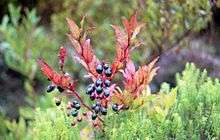Vaccinium padifolium
| Vaccinium padifolium | |
|---|---|
 | |
| Scientific classification | |
| Kingdom: | Plantae |
| (unranked): | Angiosperms |
| (unranked): | Eudicots |
| (unranked): | Asterids |
| Order: | Ericales |
| Family: | Ericaceae |
| Genus: | Vaccinium |
| Species: | V. padifolium |
| Binomial name | |
| Vaccinium padifolium J.E. Sm. ex A.Rees | |
Vaccinium padifolium, Madeira blueberry, is very common at altitudes between 800-1700 m. It grows mainly in crevices and exposed slopes and mountain plains. Fruits are used in preservers. Endemic to the islands of Madeira and Porto Santo, Portugal.
Description
Semi-evergreen scrub to small tree 1.5-6 m tall. New branches generally reddish and pubescent. Leaves often flushed dark red in autumn 2.5-7 x 1-2(2.5) cm, oblong to elliptic, acute to acuminate, petiole short, pubescent. Calyx 3-4 mm, with 5 short, broad lobes up to 1.5 mm. Flowers on curved pedicels in erect, axillary, bracteates racemes. Corolla, 7-10 mm, globose to campanulate, the lobes very short. There are often five broad rose stripes on the white corolla. Berries up to 12 x 10 mm, ripening blue-black.
Chemistry
The blue color of the berries is due to anthocyanins (Delphinidin 3-O-α-rhamnoside and anthocyanins triglycosides).[1]
Picture gallery
 Vaccinium padifolium shrubs on a slope in front of a view towards São Vicente in Madeira, Portugal.
Vaccinium padifolium shrubs on a slope in front of a view towards São Vicente in Madeira, Portugal. Vaccinium padifolium bushes on a slope in front of a view towards São Vicente.
Vaccinium padifolium bushes on a slope in front of a view towards São Vicente. Vaccinium padifolium.
Vaccinium padifolium. Vaccinium padifolium, flowers.
Vaccinium padifolium, flowers. Vaccinium padifolium.
Vaccinium padifolium. Vaccinium padifolium, autumn leaves.
Vaccinium padifolium, autumn leaves. Vaccinium padifolium, over 2 m high shrub.
Vaccinium padifolium, over 2 m high shrub.
References
| Wikimedia Commons has media related to Vaccinium padifolium. |
- ↑ Anthocyanin trisaccharides in blue berries of Vaccinium padifolium. Luis Cabrita, Nils Åge Frøystein and Øyvind M. Andersen, Food Chemistry, Volume 69, Issue 1, April 2000, Pages 33–36, doi:10.1016/S0308-8146(99)00230-7
- Flora Endémica da Madeira, Roberto Jardim, David Francisco, Múchia, Publicações, 1ªed, 2000, Portugal, ISBN 972-8622-00-7
- J. R. Press and M. J. Short, Flora of Madeira, ISBN 9781 898 29880 9, 2001, Natural History Museum, UK,